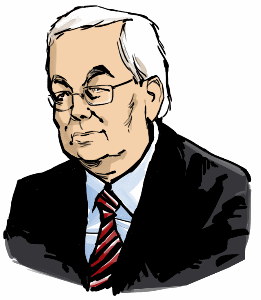© Gunnar Tómasson
22 April 2015.
Introduction
(Wikipedia)
Thomas Stearns Eliot (1888 – 1965) was an essayist, publisher, playwright, literary and social critic and „one of the twentieth century’s major poets.“ He was born in St. Louis, Missouri to an old Yankee family. However he emigrated to England in 1914 (at age 25) and was naturalised as a British subject in 1927 at age 39.
Eliot attracted widespread attention for his poem The Love Song of J. Alfred Prufrock (1915), which is seen as a masterpiece of the Modernist movement. It was followed by some of the best-known poems in the English language, including The Waste Land (1922), The Hollow Men (1925) […] He was awarded the Nobel Prize in Literature in 1948, „for his outstanding, pioneer contribution to present-day poetry
The Hollow Men appeared in 1925. […] It is Eliot’s major poem of the late 1920s. […]
[A critic] perceived a shift in Eliot’s method, writing that, „The mythologies disappear altogether in The Hollow Men.“ This is a striking claim for a poem as indebted to Dante as anything else in Eliot’s early work […] The „continuous parallel between contemporaneity and antiquity“ that is so characteristic of his mythical method remained in fine form. The Hollow Men contains some of Eliot’s most famous lines, notably its conclusion:
This is the way the world ends
Not with a bang but a whimper.
***
The Hollow Men is a masterpiece of Saga Cipher Poetry in the Saga-Shakespeare tradition. And just like Bach’s musical compositions, T. S. Eliot’s poem has a precise mathematical aspect which a reader versed in the imagery and mathematical structure of certain key Saga-Shakespeare texts can extract from it just as a listener with perfect pitch will perceive Bach’s music in a way different from others not so endowed.
This note demonstrates T. S. Eliot’s use of (a) two reference Cipher Values from the Saga works of 13th century Iceland, (b) two reference Cipher Values of Stratfordian Myth in Elizabethan England, and two key mythical concepts in the Augustan-Saga-Shakespeare literary tradition. At the end of this note is a link to a Cipher Calculator which readers can use to double-check the Cipher Values in (a) and (b).
I. Brennu-Njálssaga
In the Saga-Shakespeare tradition, the Cipher Value of the masterpiece Brennu-Njálssaga serves as a key reference value, which is defined as the Cipher Sum of the Alpha and Omega sentences of the Saga plus the Alpha and Omege sentences of Kristniþáttur (Advent of Christianity) which is inserted in the Saga as Chapters 100 – 105 of its 159 Chapters:
6257 = Mörðr hér maðr. (Man was named Mörðr.)
12685 = Höfðingjaskipti varð í Nóregi. (There was a change of chieftains in Norway.)
11274 = Fara menn við þat heim af þingi. (At that people go home from althing.)
13530 = Ok lýk ek þar Brennu-Njálssögu. (And there I conclude the Saga of Burnt Njáll.)
43746
II. The Hollow Men – Omega section
6668 = Between the idea
5793 = And the reality
9496 = Between the motion
3839 = And the act
7917 = Falls the Shadow
10033 = For Thine is the Kingdom
43746
III. Snorri Sturluson – Author of Edda
The so-called Uppsala Edda manuscript contains the sole extant reference to Snorri Sturluson as author of Edda, with the text thereof written boldly across the top of the first page. The spelling of the text is replete with errors which generally serve two purposes: (1) To signal possible interesting cipher content of the text, and (2) to align the text precisely with the desired Cipher Value.
On a visit to the Icelandic National Library in Reykjavík many years ago, I checked out the library’s photocopy of the manuscript and wrote down the following letter-perfect version of the text:
8542 = Bók þessi heitir Edda.
20156 = Hana hevir saman setta Snorri Sturlo son
15735 = eptir þeim hætti, sem hér er skipat.
10539 = Er fyrst frá ásum ok Ymi
18224 = þar næst skalldskap ok heiti margra hluta.
17723 = Síþaz Hatta tal er Snorri hevir ort
13512 = um Hak Konung ok Skula hertug.
104431
Loose translation: This book is named Edda. It has been put together by Snorri Sturluson in the manner which is here ordered. First is an account of the Aesir and Ymir, thereafter poetry and the names of many things. Last poems which Snorri has composed for King Hakon and Duke Skuli.
IV. Hollow Man/Imperfect Book/Brave New World
In Saga-Shakespeare Myth, Light of the World, 1000, is incarnate in Imperfect Book/ World/Man/The Globe set on a course to Destruction and Rebirth as Perfect Book/Man/Brave New World. The number symbol for Perfect Man is 432. In Shakespeare Myth, the Stratfordian’s “hour upon the stage” of The Globe begins with baptism and ends with burial.
The seven Omega lines of The Hollow Men begin with imperfect lines, with the four concluding lines echoing an accelerating rush to a world-ending BANG – a sexual allusion signaling “death” of mythical Old Man and Rebirth of New Man. In ancient creation myth, the concept of MAN denotes Giver of Life, Man in the Image of God, Man as Microcosmos or Brave New World:
1000 = Light of the World – Incarnate in Stratfordian
17252 = Gulielmus, filius Johannes Shakspere – baptismal name
5608 = For Thine is
2763 = Life is
7135 = For Thine is the
15417 = This is the way the world ends
15417 = This is the way the world ends
15417 = This is the way the world ends
13964 = Not with a bang but a whimper.
10026 = Will Shakspere gent. – burial name
432 = Right Measure of Man
104431
***
Calculator for converting letters to cipher values is at:
http://www.light-of-truth.com/ciphersaga.htm

 Gunnar Tómasson
Gunnar Tómasson